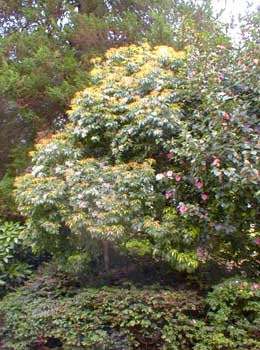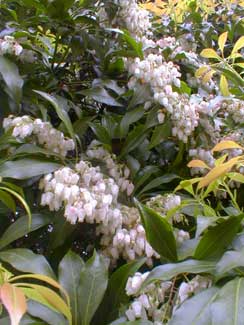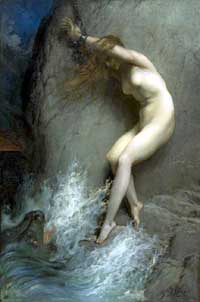
Japanese Andromeda
"Unbind Andromeda! She was not born
To stand & shiver in the northern blast,
Or fester on a foreign rock, or bear
Rude licence of the unrespective waves."
-Sydney Thompson Dobell
(1824-1874)
(1824-1874)
Modern Andromeda cultivars are mainly slow-growing compact shrubs in the two to five foot range of height (see for example 'Mountain Fire').
Pieris japonica when crossed with the smaller J. floribunda loses its capacity for enormity. Such hybrids have almost entirely displaced the species shrub form the marketplace, but until the last twenty years or so, the species shrub Pieris japonica was the garden standard.
 It is in its natural state an enormous shrub easily reaching ten feet & often much, much larger, nearly as wide as it is tall. Thus large old specimens encountered in cemeteries or gardens planted decades ago predate the popularity of small to moderate-sized cultivars.
It is in its natural state an enormous shrub easily reaching ten feet & often much, much larger, nearly as wide as it is tall. Thus large old specimens encountered in cemeteries or gardens planted decades ago predate the popularity of small to moderate-sized cultivars.In the alley across the street from our home there's a shady area very well gardened decades anon, & included in the array of big shrubs is a Japanese Andromeda about fifteen feet tall. It's shown in the first photo above, in April, alongside a large Camellia williamsii x oleifera 'Ice Follies.'
The species shrub is white-flowered (some cultivars have pink flowers). March & April's chains of urn-flowers are pure white, shown in the second photo.
 These chains give the genus its common names Fetterbush & Andromeda. The beauty of the chain-flowers evidently evoked the ultimate bondage fantasy of ancient Myth, with the beautiful & blameless Ethiopic princess Andromeda bound to a rock exposed to the dragon-infested sea, with Medusa-beheading Perseus rushing to her aid. The portrait of Andromeda included on this page is by Gustav Dore.
These chains give the genus its common names Fetterbush & Andromeda. The beauty of the chain-flowers evidently evoked the ultimate bondage fantasy of ancient Myth, with the beautiful & blameless Ethiopic princess Andromeda bound to a rock exposed to the dragon-infested sea, with Medusa-beheading Perseus rushing to her aid. The portrait of Andromeda included on this page is by Gustav Dore.The urn-shaped flowers look like blueberry blooms because both blueberry & pieris are heath family shrubs. But some fancied the urns as lily-of-the-valley blooms, so that one of its common names in the west has been Lily-of-the-Valley Shrub.
Its Japanese name is Asebi. The three characters to write this name mean Horse Drunk Tree. This is because Japanese andromeda is a toxic plant, & animals that browse the leaves become intoxicated.
The shrub requires no general pruning to remain attractive. When the flower chains go to seed they're a mite homely & grey. On small shrubs they can be removed, but an old species shrub will be too large to dress, so one just has to wait for the spent flowers to drop.
New spring foliage is light green, aging to dark green. Some cultivars have bright red, pink, or silvery-yellow spring foliage that contrasts so strongly with the previous year's evergreen leaves that new terminal leaves can look like late-winter flowering. The species is more subdued in its new foliage.
In full sun Andromeda can suffer, but in deep shade flowering strength is weakened. Its ideal is bright shade, & it is one of the most important temperate broadleaf evergreen shade shrubs. It's a true temperate shrub that can have its flower buds frozen off in too cold a zone, & cannot be grown too far south. It is ultra-hardy in zones 6-8, & can be tried down to Zone 4 although with the understanding that a late freeze will ruin the early spring flowers.